Mudford Troop of Yeomanry cavalry
Mudford Troop of Yeomanry cavalry
Raised to defend Yeovil from Rioters
During the late 1820s there was ever-increasing discontent among the working-class population across the country, as demands for social, economic and political reform were being put down by reactionary governments and especially, and perhaps unsurprisingly, a hostile House of Lords. This was chiefly due to the electoral system which was corrupt and unrepresentative. At this time Members of Parliament tended to be from Britain's richest families and represented towns and boroughs where they had major control. In 1830 most of the British population was still excluded from voting, so they had no influence over the law-making process that affected their lives and consequently the poor had to endure low pay combined with harsh working conditions. Voting took place publicly so coercion became rife and, of course, the working-class people often worked for and/or lived in property owned by their MP.
In 1825 William Huskisson, President of the Board of Trade, removed all restrictions on imported gloves and exposed Yeovil glove manufacturers to unlimited competition from France. Since glove making employed something like 80% of Yeovilians, a widespread depression hit the town. The resulting depression underlies the political unrest of the time and, perhaps, the activity of a nascent radical Yeovil Political Union. This combination of political and economic factors would stimulate and encourage popular collective action in Yeovil.
|
The revolutions taking place in Europe and the growth of radical ideas in England caused such anxiety in Yeovil, as elsewhere throughout the country, that in November 1830 two hundred and fifty Special Constables were sworn in at Yeovil. In December 1830, the Mudford Troop of Yeomanry Cavalry was formed - also as a precautionary measure. Why it was called the Mudford Troop is something of a mystery since only three of its members hailed from that village, while Yeovil supplied seventeen members of the force. The Mudford Troop of Yeomanry Cavalry was established with a muster of some seventy troopers commanded by Captain George Harbin of Newton Surmaville. Second in command was Lieutenant George T Williams. Rev James Halls was Chaplain to the Troop and William Shorland was the Troop's Surgeon. John Slade, whose house was attacked in the Yeovil Reform Riot of 21 October 1831, was commissioned Cornet of the Troop (Cornet was originally the lowest grade of commissioned officer in a British cavalry troop, the modern equivalent being a second lieutenant. The Cornet was the bearer of the Troop's flag, or Cornet). |
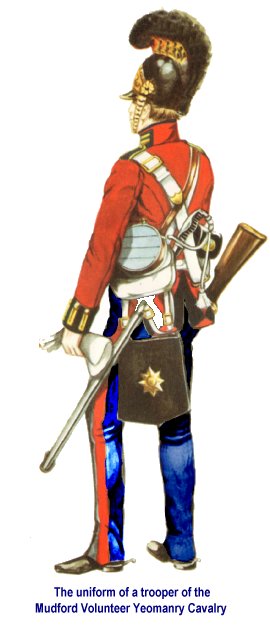 |
The Mudford Troop of Yeomanry, under the command of Captain George Harbin, assembled on the morning of Saturday, 22 October 1831. Bearing in mind the distances between the homes of the Mudford Troop's members (see map below) I hypothesise that (and, of course, other than logic, I have nothing to back this up), the fact that the Mudford Troop was called out by the Yeovil magistrates during the early hours of Saturday morning 22 October and they were patrolling the streets of Yeovil later that same day, indicates to me that trouble had been expected and the troop had already been mustered in anticipation of disorder. There could be no other way of mustering the troop from their widespread homes in such a short timescale.
The Mudford Troop were later joined by the Martock Troop of Yeomanry under the command of Captain Tatchell. During Saturday the Yeomanry patrolled the streets and brought a small measure of calm to the town.
Towards evening, the rioters were threatening to sack the town and pelted the Yeomanry with stones and other missiles. The Yeomanry arrested two of the mob and took them to the Mermaid Inn where the Magistrates were gathered. The Mermaid Inn was attacked, windows broken, and the rioters attempted to rescue those that had been arrested. It was reported by the Western Flying Post that the Mudford Troop "left the town under the idea that their presence might be the means of bringing together a crowd."
The crowd finally dispersed, although the Yeomanry had to provide constant patrols through the night to keep the streets clear and maintain order. On the Sunday morning, a detachment of the 3rd Dragoon Guards, a troop of regular cavalry normally stationed in Taunton, arrived from Sherborne, where they had been keeping the peace, and order was finally restored in Yeovil.
To show their appreciation of the good conduct of the troops, the townspeople of Yeovil subscribed £225 (roughly £18,000 at today's value) and presented every member of the Mudford Troop of Yeomanry with an inscribed 'Riot Jug' (see photograph and description below). Since the Mudford Troop "left the town" during the Saturday night riot, leaving the Martock Troop to quell the rioters, it seems a little unfair that the officers and men of the Martock Troop were not similarly rewarded.
George Harbin was Captain Commandant of the unit from its enrolment in December 1830 until it was disbanded on 25 March 1838.
Muster Roll of the Mudford Troop of Yeomanry cavalry
| Mudford Independent Corps of Yeomanry Cavalry receiving Riot Jugs | |||||||
| Muster Roll return for 5 April 1832 to 5 April 1833 | |||||||
| Parish | Name | Age | Occupation | Date enrolled | Jug Location | ||
| Yeovil | George Harbin, Captain | 31 | Gentleman | 3 Feb 1831 | |||
| Limington | George T Williams, Lieut | 34 | Barrister | 3 Feb 1831 | |||
| Yeovil | John Slade, Cornet | 32 | Solicitor | 3 Feb 1831 | Wareham | ||
| Marston Magna | Rev James Halls | Vicar | 3 Feb 1831 | ||||
| Yeovil | William Shorland, Surgeon | 30 | Surgeon | 3 Feb 1831 | |||
| Rimpton | Edward Genge, Q'master | 47 | 3 Feb 1831 | Exists - Note 1 | |||
| Yeovil | John Rooking | 3 Feb 1831 | |||||
| Marston Magna | Samuel Guppy, Sergeant | 3 Feb 1831 | |||||
| Limington | William Longman, Sergeant | 3 Feb 1831 | |||||
| Marston Magna | Henry Stacey, Corporal | 35 | 3 Feb 1831 | Exists - Note 2 | |||
| Yeovilton | John Farnwell, Corporal | 11 Feb 1831 | |||||
| Preston Plucknett | William Trask, Corporal | 35 | Farmer | 3 Feb 1831 | |||
| Yeovil | George R Lov (?) | 11 Feb 1831 | |||||
| Draycott | Joseph Barnett | 3 Feb 1831 | Mudford | ||||
| Babcary | William Bartlett | 45 | Independent | 3 Feb 1831 | |||
| Rimpton | James Bewsey | 35 | Farmer | 3 Feb 1831 | |||
| Yeovil | Henry Bracker | 20 | Butcher | 11 Feb 1831 | |||
| Podimore | Henry Brooks | 3 Feb 1831 | Exists - Note 3 | ||||
| Yeovil | John Brook | 24 | Farmer | 10 Nov 1831 | |||
| Yeovil | Joseph Brook | 32 | Farmer | 11 Feb 1831 | |||
| Yeovil | John Cary | 3 Feb 1831 | |||||
| Marston Magna | John Caines | 3 Feb 1831 | Exists - Note 4 | ||||
| West Camel | John Gistock Caines | 3 Feb 1831 | |||||
| Charlton | John Coles | 20 | Farmer | 23 Nov 1831 | |||
| Sparkford | Job Cox | 30 | Farmer | 11 Feb 1831 | Exists - Note 5 | ||
| Sandford Orcas | William Down | 11 Feb 1831 | |||||
| Compton Pauncefoot | William Dodd | 17 Nov 1831 | |||||
| Preston Plucknett | Samuel Dunn | 3 Feb 1831 | |||||
| Yeovil | George Edwards | 35 | Painter | 16 May 1831 | CHAC | ||
| Corton Denham | John French | 20 | Farmer | 3 Feb 1831 | Sold at Bath | ||
| Mudford | Samuel French | 3 Feb 1831 | Exists | ||||
| Chilton Cantello | George Genge | 3 Feb 1831 | |||||
| Limington | Henry Genge | 3 Feb 1831 | Rimpton | ||||
| Limington | John Genge | 12 Feb 1831 | |||||
| Northover | Charles Harris | 30 | Civil Engineer | 3 Feb 1831 | |||
| Mudford | George Hayward | 3 Feb 1831 | |||||
| Preston Plucknett | John Noake Highmore | 22 | Wool Stapler | 17 Nov 1831 | |||
| Queen Camel | William M Ley | 3 Feb 1831 | |||||
| Odcombe | Isaac Kiddle | 20 | Farmer | 11 Feb 1831 | |||
| Yeovil | John Longman | 21 | Farmer | 3 Feb 1831 | |||
| Yeovil | Thomas Lukins | 40 | Inn Keeper | 3 Feb 1831 | |||
| Chilton Cantello | William Marden | 41 | Baker | 3 Feb 1831 | |||
| Trent | Samuel Marsh | 26 | Farmer | 3 Feb 1831 | |||
| Trent | Henry F Masters | 3 Feb 1831 | |||||
| Sparkford | John Masters | 11 Feb 1831 | CHAC | ||||
| West Camel | George Midlane | 3 Feb 1831 | |||||
| West Camel | John Midlane | 3 Feb 1831 | CHAC | ||||
| Yeovil | Francis Morrish | 3 Feb 1831 | |||||
| Yeovilton | Charles Old | 45 | Flax Spinner | 11 Feb 1831 | N Yorks | ||
| Ilchester | Robert Payne | 54 | Butcher | 3 Feb 1831 | |||
| Mudford | John Palmer | 16 | Farmer | 3 Feb 1831 | |||
| Compton Pauncefoot | Mathew Paul | 38 | Farmer | 17 Nov 1831 | |||
| Yeovil | Thomas Plowman | 59 | Saddler | 3 Feb 1831 | |||
| Yeovil | Robert Raymond | 19 | Saddler | 3 Feb 1831 | CHAC | ||
| Limington | James Sealy | 3 Feb 1831 | Exists | ||||
| West Camel | William Sealy | 3 Feb 1831 | |||||
| Barwick | Edward Symes | 35 | Farmer | 11 Feb 1831 | |||
| Sparkford | Henry Symes | 3 Feb 1831 | |||||
| Marston Magna | James Taylor | 40 | Farmer | 3 Feb 1831 | Chippenham | ||
| Yeovilton | James Trent | 42 | Farmer | 3 Feb 1831 | |||
| Yeovilton | Samuel Trent | 38 | 3 Feb 1831 | Exists - Note 6 | |||
| Yeovil | William Tucker | 28 | Leather Dresser | 3 Feb 1831 | Wareham | ||
| Queen Camel | John Vincent | 37 | Ag Lab | 3 Feb 1831 | Queen Camel | ||
| Marston Magna | Edward Willis | 14 Jun 1832 | |||||
| Odcombe | Samuel Young | 17 | 21 Feb 1831 | ||||
| Yeovil | Richard May | 25 | Surveyor | 23 May 1832 | |||
| Queen Camel | Charles Ley | 3 Feb 1831 | |||||
| Non Effectives | |||||||
| West Lydford | Antony Goldney | 20 Sep 183? | |||||
| Sparkford | Francis Symes | 23 Oct 183? | |||||
| Limington | Robert Sealy | 45 | Yeoman | 25 Mar 183? | |||
| Limington | James Mills | 25 | 10 Aug 183? | ||||
| Retired since Last Roll | Date Retired | ||||||
| Charlton Mackrell | Joseph Hallett | 26 Nov 1832 | |||||
| Marston Magna | James Jolliff | 55 | Independent | 20 Oct 1832 | |||
| Tintinhull | Thomas Look | 45 | Farmer | 30 May 1832 | |||
| Corton Denham | Thomas Barrett | 20 | 28 Sep 1832 | ||||
I have managed to trace details of 42 members of the troop. Their ages ranged from 16 to 59, with the average age being 33. I have also managed to trace the trades or professions of 37 of these. Of these 37 men, 18 (50%) were farmers which at first I found surprising, before I realised that the farming community were the most likely people to own horses - a prerequisite if you're going to join volunteer cavalry.
Note 1 - Sold at
auction, 19
September 2020
for £350
Note 2 - Broken
and glued. This
is currently
(2022) in a shop
in Texas, USA
Note 3 - Sold at
UK auction,
March 2022 for
£95
Note 5 -
Auctioned 6
October 2016.
Estimate £200 to
£300. Unsold
Note 6 - Sold at
UK auction, 13
November 2014
Note 7 -
Auctioned in
Cincinnati,
Ohio, USA on 30
September 2021.
Exceeded $800
Map
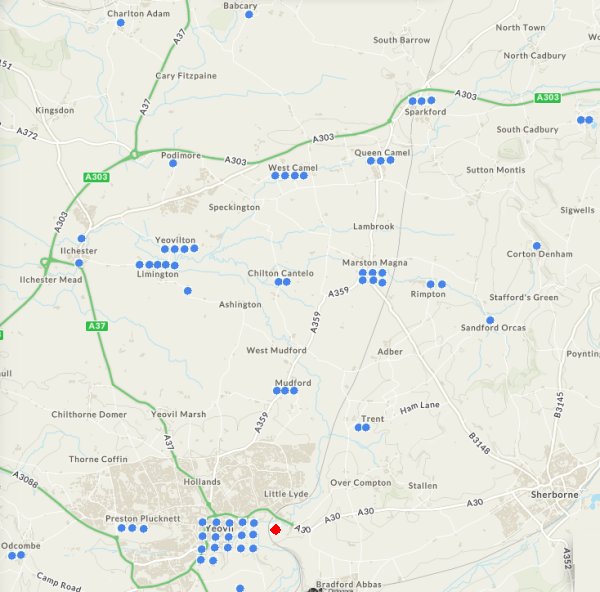
This map shows, with blue dots, the locations of the homes of members of the Mudford Troop of Yeomanry Cavalry. The red dot is Newton Surmaville, the home of George Harbin who commanded the troop.
gallery

The announcement of the formation of the Mudford Troop of Yeomanry Cavalry, raised by John Goodford of Chilton Cantelo and under the command of George Harbin of Newton Surmaville in the 8 January 1831 edition of the Berkshire Chronicle.

The notice of the Commissions of officers of the Mudford Troop of Yeomanry Cavalry from the 26 February 1831 edition of the Sun (London).
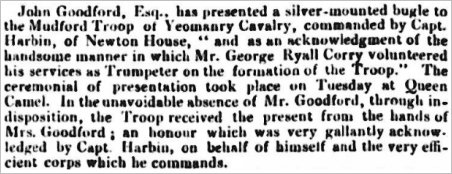
A report from the 28 May 1832 edition of the Bristol Mirror describing the presentation of a silver-mounted to the Mudford Troop, and especially George Ryall Corry who volunteered to be the troop's trumpeter.
![]()
In 1831, troopers of the Mudford Troop were dressed as heavy dragoons with black japanned Romanesque helmet with brass fittings and a black crest. The coatee was scarlet with single row of brass buttons down the front. The collar and pointed cuffs were blue and the tunic was piped in blue. Officers wore a gilt loop with button on the collars, but whether other ranks wore loops is unknown. Trousers were dark blue with scarlet stripe. The Mudford Troop was disbanded in 1838.
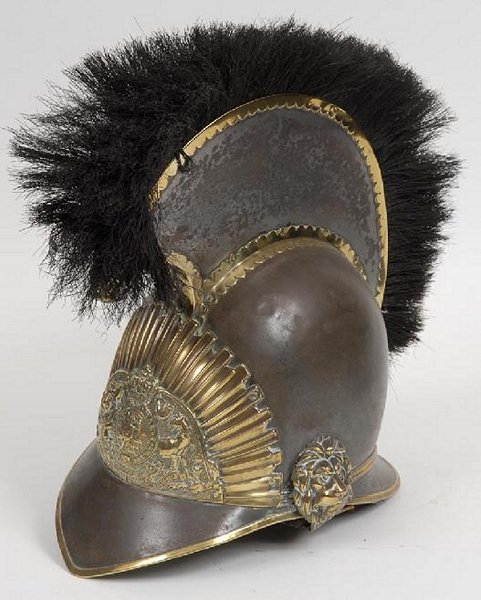
This photograph
features in my
book 'Secret Yeovil'.
A Yeomanry Cavalry helmet of steel and brass construction with a black plume and a Royal Coat of Arms on a sunburst plate. Worn by the Mudford Independent Yeomanry Cavalry. This was auctioned in 2007.
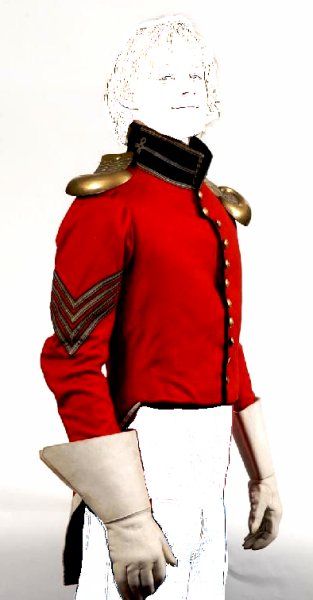
A Sergeant's tunic of the Mudford Yeomanry Cavalry, complete with brass epaulettes and gloves of c1830. The troop was raised by Capt. Harbin of Newton Surmaville. This tunic was auctioned in 2007.
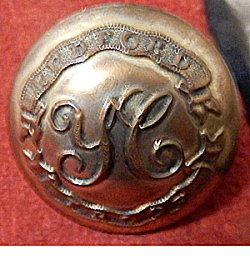 At
left is a
photograph of
the style of
button used on
the Mudford
Troop of
Yeomanry
Cavalry's tunic
as above but
from the example
held at the
Community
Heritage Access
Centre. There
were nine
buttons of this
design on the
tunic with a
further two at
the bottom -
these would have
been covered
with a sash and
were plain so
that the sash
material didn't
snag.
At
left is a
photograph of
the style of
button used on
the Mudford
Troop of
Yeomanry
Cavalry's tunic
as above but
from the example
held at the
Community
Heritage Access
Centre. There
were nine
buttons of this
design on the
tunic with a
further two at
the bottom -
these would have
been covered
with a sash and
were plain so
that the sash
material didn't
snag.
The top half of the button contains 'MUDFORD' in a decorative banner and a leafy swag to the bottom half. The initials 'YC' in the centre stand for 'Yeomanry Cavalry'.
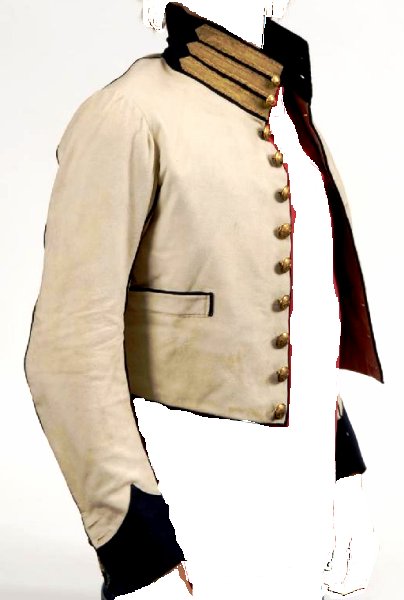
An officer's waistcoat of the Mudford Yeomanry Cavalry, complete with brass buttons. This was worn without a sash (and therefore didn't have plain bottom buttons as the red jacket above). This waistcoat was auctioned in 2007.
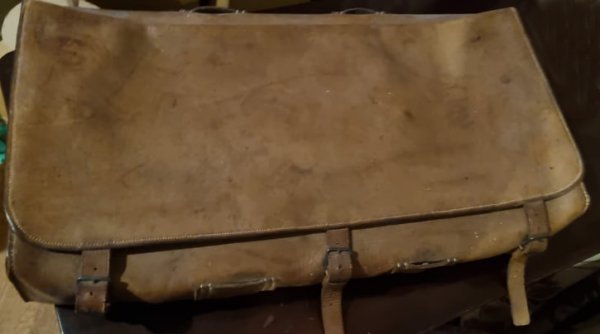
Courtesy of
Stephen Bartlett
Captain George Harbin's leather campaign knapsack. The campaign knapsack carried a knife, fork and spoon, a cup and tin plate, shaving kit, hoof pick and horse brush. The blanket was rolled up and placed on top with leather straps. Only the Captain had his name on his knapsack (see below), the troopers' knapsacks were simply numbered 1 to 65.
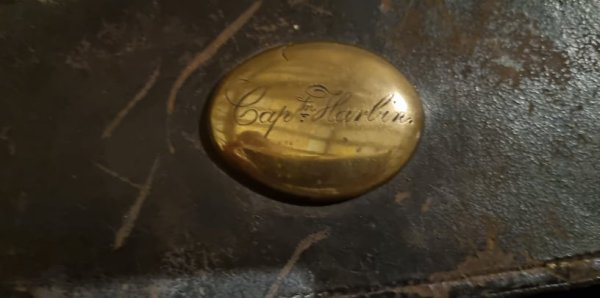
Courtesy of
Stephen Bartlett
This is the second brass nameplate on Captain George Harbin's campaign knapsack. The nameplate is engraved 'Captn Harbin'.
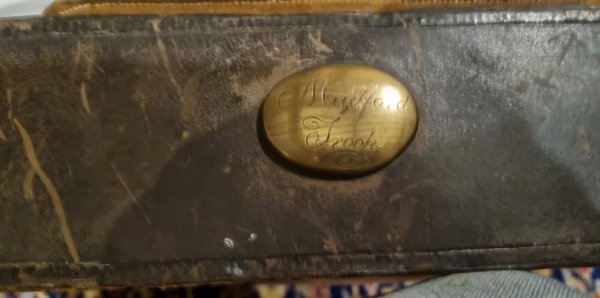
Courtesy of
Stephen Bartlett
This is the second brass nameplate on Captain George Harbin's campaign knapsack. The nameplate is engraved 'Mudford Troop'.
![]()
The Riot Jugs
Every member of the Mudford Troop of Yeomanry Cavalry was presented with a commemorative salt-glazed stoneware 'Riot Jug' made by Doulton & Watts at their Lambeth works. The jugs were 9¾" (247mm) high and decorated in relief with the Royal Arms on one side, a sheaf of corn, farming implements, vine and grape decoration on the other side and with a silver presentation plaque on the face opposite the handle.
The first three photographs below are of an almost unique undecorated 'proof' jug with a space for the silver plaque on the front. This 'proof' jug was auctioned in 2018.
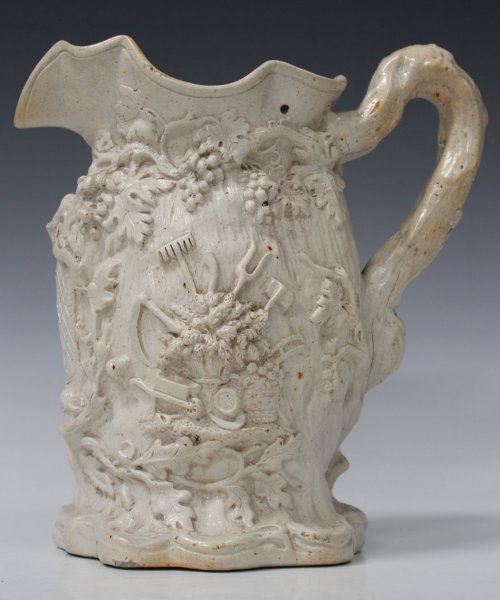
The farming implements surrounded by a vine with grapes.
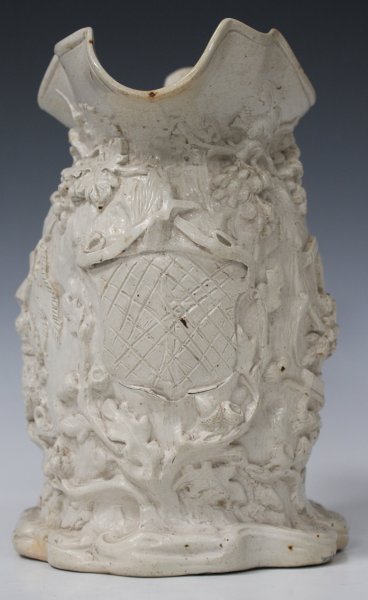
The 'front' of the jug. The area where the silver presentation plaque will be affixed has been cross-hatched to ensure a good adhesion for the plaque.
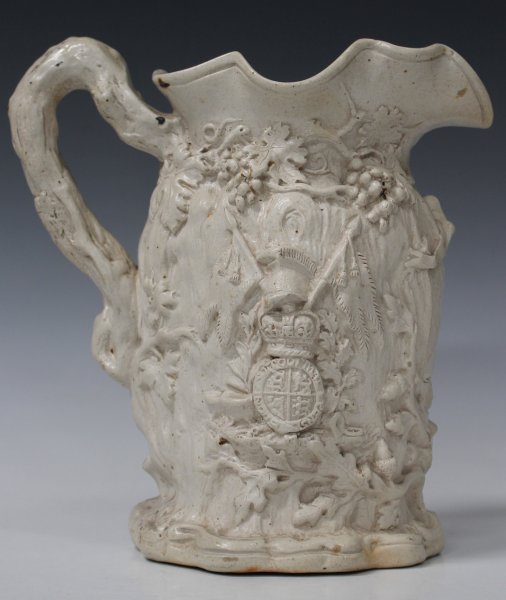
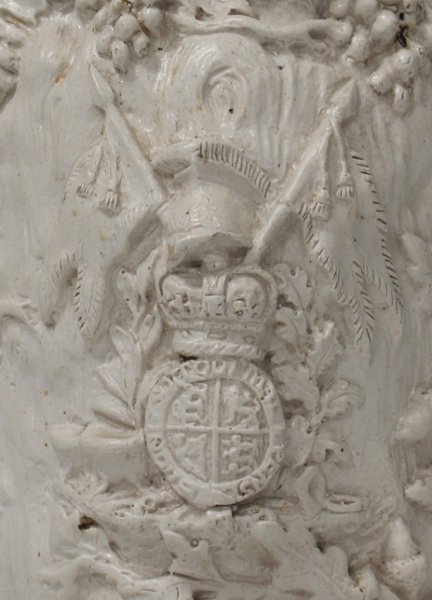
With the jug's pouring lip facing towards you, this is the decoration on the left side. It is the royal coat of arms, surmounted by a Yeomanry Cavalry trooper's helmet (see above) flanked by a pair of cornets or pennants.
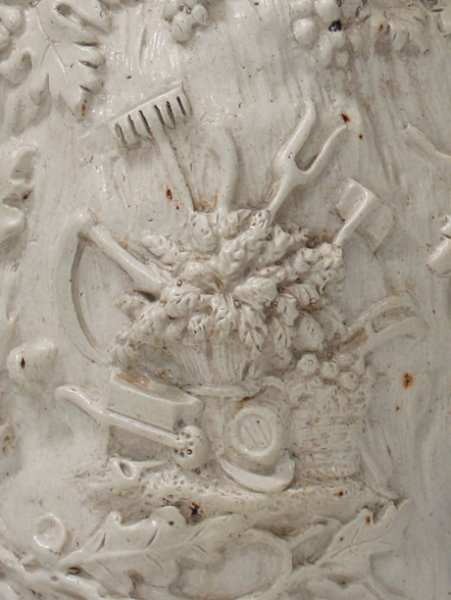
With the jug's pouring lip facing towards you, this is the decoration on the right side. Around the central sheaf of wheat are (from bottom left and proceeding clockwise) farming implements - a wheelbarrow, a scythe, a rake, a pitchfork, a spade, a bow-saw (?), a basket (of fruit ?) a barrel and a sickle.
![]()

This photograph
features in my
book 'Secret Yeovil'.
This is a decorated salt glaze stoneware Yeovil 'Riot Jug' as presented. It is 9¾" (247mm) high and decorated in relief and with silver presentation plaque inscribed, in this instance, "Presented by the Inhabitants of Yeovil and its vicinity in testimony of their approval of the conduct of the Mudford Troop of Yeomanry Cavalry during the riots in that town in 1831. To Mr J A S Sealy". This particular jug was put up for auction in April 2011 but was unsold.
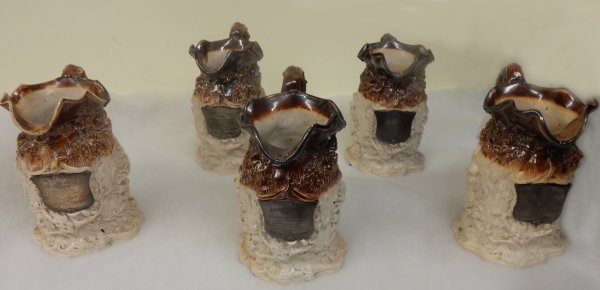
Courtesy of South Somerset Heritage Collection
The five 'Riot Jugs' held in the Community Heritage Access Centre, Yeovil. These are the jugs presented to John Midlane, George Edwards, John Masters, Robert Raymond and Samuel Young - all members of the Mudford Troop. It would appear that the Martock troop were not presented with jugs.
Although unmarked, it is known that the 'Riot Jugs' were made by Doulton & Watts at their Lambeth works.
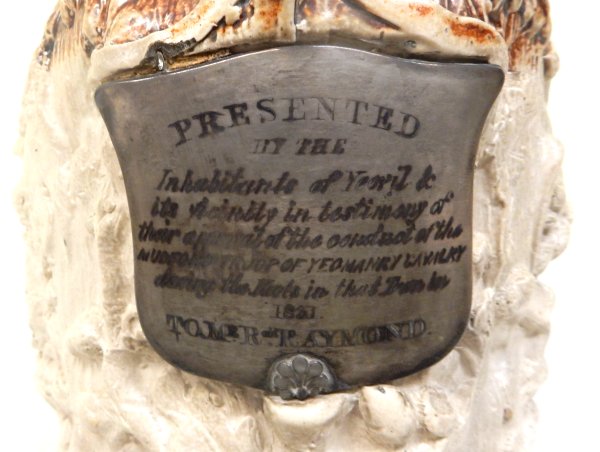
Courtesy of South Somerset Heritage Collection
A typical silver presentation plaque from a riot jug. All inscriptions are identical apart from the name of the recipient. For clarity, the inscription reads "PRESENTED BY THE Inhabitants of Yeovil & its vicinity in testimony of their approval of the conduct of the MUDFORD TROOP OF YEOMANTY CAVALRY during the Riots in that Town in 1831" followed by the name of the recipient, in this case "TO Mr Robt RAYMOND".
At the time of the riot, Robert Raymond (1812-1880) was 19-years-old and was the son of Edward Raymond (1775-1856) and Martha née Feaver (1781-1858) of Kingston. Robert would later become a saddler.
![]()
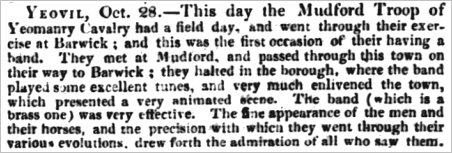
A report from the 29 October 1835 edition of the Dorset County Chronicle describing a field day held by the Mudford Troop featuring the first appearance of the troop's brass band.
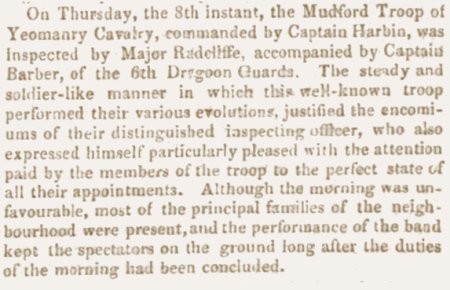
A report of a review of the Mudford Troop from the 19 June 1837 edition of the Western Flying Post.
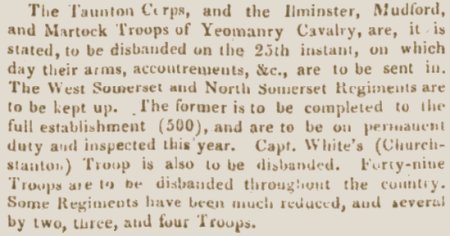
A report in the 19 March 1838 edition of the Western Flying Post, announcing the disbanding of several troops of Yeomanry Cavalry, including both the Mudford and Martock troops.
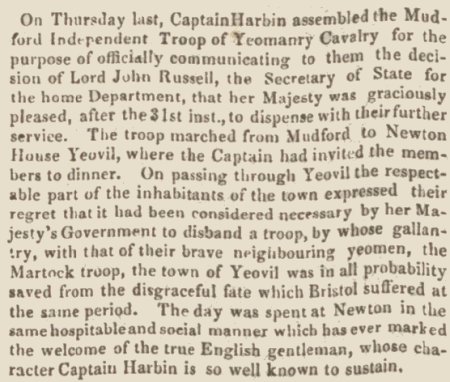
The report from the 2 April 1838 edition of the Western Flying Post in which Captain Harbin announced to the Mudford Troop of the decision to disband it.
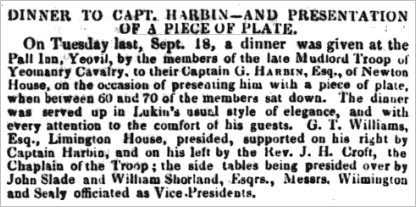
A report from the 27 September 1838 edition of the Dorset County Chronicle and Somerset Gazette, on the dinner held following the disbanding of the Mudford Yeomanry. I've omitted all the speeches, etc.
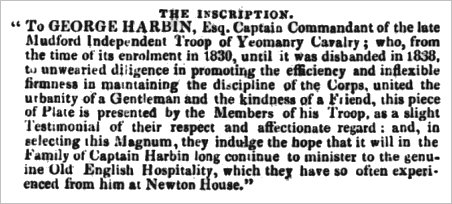
The inscription on the plate presented to George Harbin from the 20 September 1838 edition of the Dorset County Chronicle.
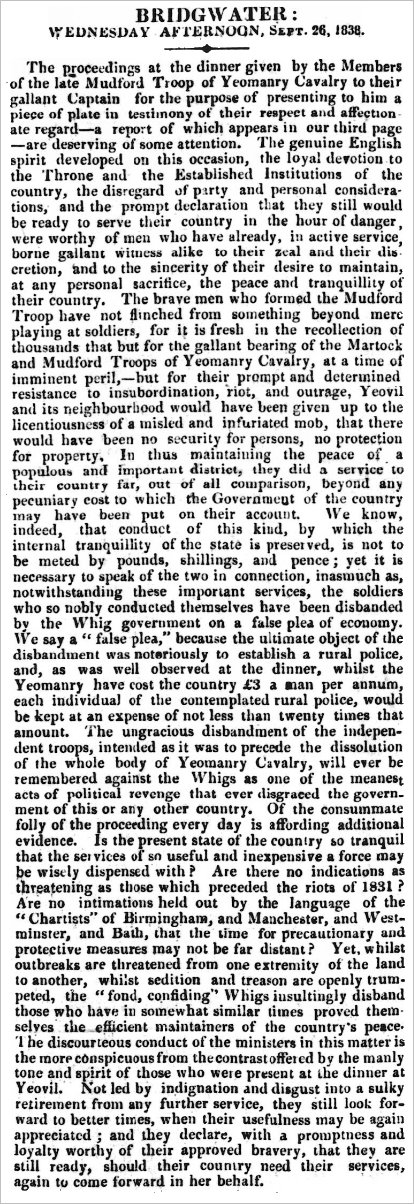
A report from the 27 September 1838 edition of the Dorset County Chronicle and Somerset Gazette, decrying the disbanding of the Mudford Yeomanry.